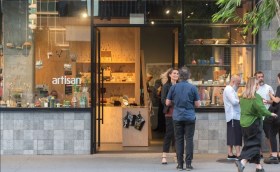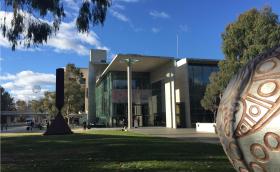Time Flies, Image via Melbourne Design Market
Labor has plans for the arts and culture in Victoria. The victory of Daniel Andrews on November 29 brings a new approach to cultural policy in the Garden State, and with it, significant bureaucratic change.
Those reforms will be watched closely, both by the sector in Victoria, as well as across the country. They’re big.
First and foremost, Victoria no longer has a Minister for the Arts. Martin Foley was sworn in yesterday as Victoria’s first Minister for Creative Industries, subsuming the old Arts portfolio and signaling a bold new direction for cultural policy under the Andrews government.
In a pre-election interview with Arts Hub, Foley described the incipient policy as about “empower[ing] the hand-to-hand combat over government resources.” The new department is expected to bring cultural agencies like Arts Victoria, Film Victoria and Design Victoria together under a single minister (Design Victoria, for instance, was previously in the State Development portfolio).
In his interview, Foley claimed the new policy blueprint would be double-headed. A new arts and cultural strategy will be developed to sit alongside a creative industries policy in an overall public policy mix. How will that play out? What those policies will contain? We’ll just have to wait and see.
Creative industries policies aren’t new. The idea began in municipal politics in London in the 1980s and eventually spread around the world, championed by the Blair government in Britain and faddish intellectuals like Charles Landry and Richard Florida.
They’ve been tried before in Australia, too: the Queensland government under Peter Beattie established a formal creative industries policy in 2003. It’s title, Creativity is big business, aptly captured the industrial goals of its framers.
In general, creative industries policies attempt to frame the arts and culture as industries that deserve their own industry policies. For a Labor government, the expected pay-off is generally employment growth: the hope (some would say dream) that the disparate and often fragile elements of artistic and cultural endeavor can be nurtured towards rude economic health.
Along with these new goalposts comes a new scoreboard. Jobs, businesses and exports tend to become the new metrics by which cultural activity is measured. Words like “sustainability” and “viability”, already the bane of arts company managers, become more prominent. In general, there is an expectation that the arts and cultural sector should contribute to economic growth, and that government funding will become more like an investment, and less like a subsidy. One recent academic study from Britain laments the “near-obsessive focus on the methods and practices of monitoring and evaluation.”
For these and many other reasons, there is a lively academic debate in the specialist literature about whether creative industries policies are neoliberal and counter-productive. The debate is especially intense in the United Kingdom, where the sequel to significant extra funding under the Blair government was a period of savage austerity following the global financial crisis and the election of he government of David Cameron.
The spotty record of creative industries policy continues in Australia. Queensland’s creative industries moment was particularly instructive: despite enthusiastic support from the Labor governments of Beattie and Bligh, and an influential academic cheer squad based at QUT, the policy itself was never more than an add-on to traditional state policy priorities, which centred around the perpetual funding of big public cultural institutions.
Disappointingly, Creativity is big business failed to deliver the jobs bonanza hoped for it: census data revealed that employment growth in the cultural sector in the state was almost non-existent. A decade on, the greatest legacy of the Labor years in Queensland is the hugely popular Gallery of Modern Art, a traditional public art museum that has relatively little “creative industries” about it.
This failure was not entirely the fault of the designers and implementers of Queensland’s policy. Much of the blame could be sheeted home to factors well outside the control of any state government: the sky-high Australian dollar, for instance, which made overseas feature film production on the Gold Coast uncompetitive, and which systematically destroyed Brisbane’s once-vibrant games industry.
But these macroeconomic trends show just how difficult it can be for creative industries policies to bear fruit. Indeed, for all the effort ploughed into capturing better metrics and indicators, its not immediately obvious that Minister Foley will have the data he needs to show that any new policy is working or not. With the abolition of the Australian Bureau of Statistics’ cultural statistics unit, the new Ministry is effectively flying blind.
In summary, Foley has his work cut out for him. As well as developing a new policy framework, he’s going to have to calm jangled nerves in the heritage arts sector, where creative industries is often considered a code word for attacking the traditional verities of art for art’s sake. He also has the rather significant bureaucratic challenge of bringing together a disparate group of government agencies under a new ministry, and getting them to cooperate and collaborate.
That’s not to say we shouldn’t welcome a new approach to cultural policy at the state level in Australia. Despite the attention given to the Australia Council and the ABC, the states and territories remain key players in the Australian cultural policy space. If Foley can reinvigorate cultural policy in Victoria, long one of the cultural powerhouses of the Commonwealth, then he has a chance to make a real mark.
With Federal Labor beginning to show interest in cultural policy again in opposition, the new policy will be closely watched.






